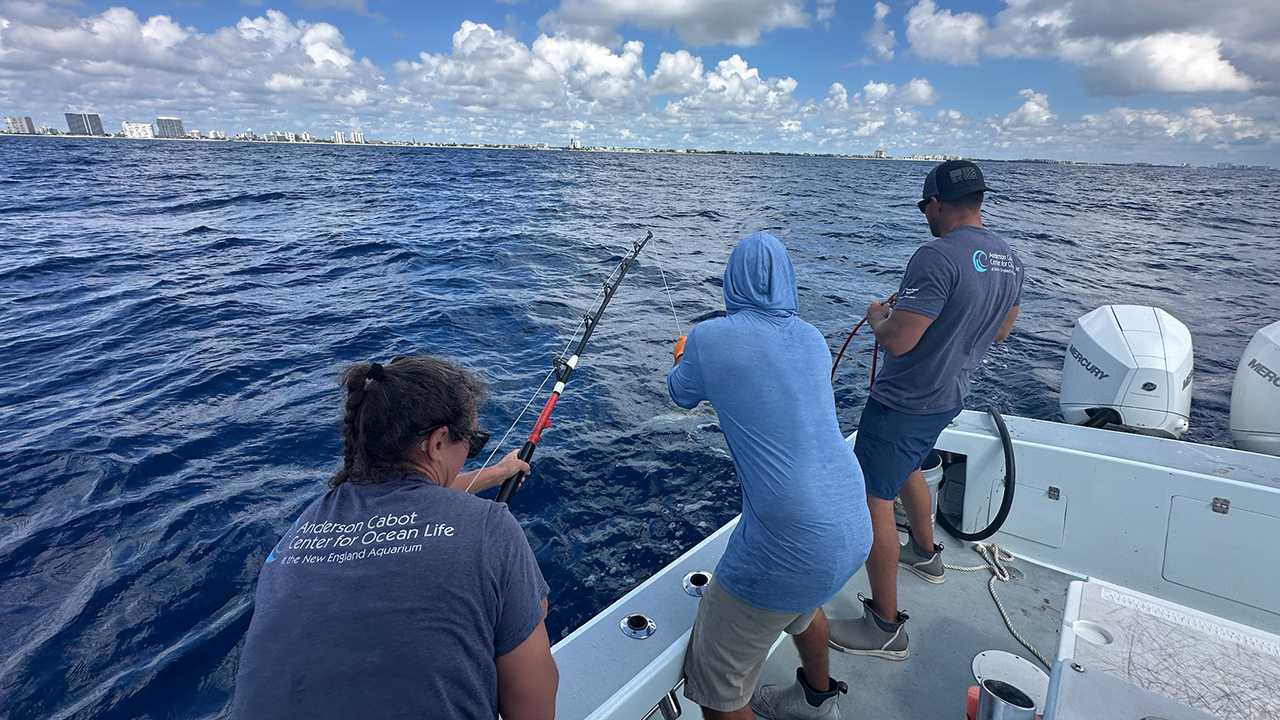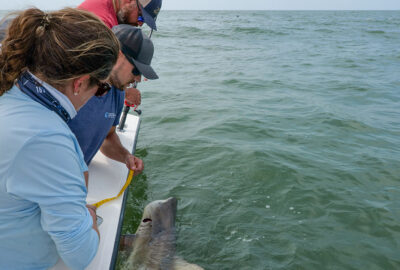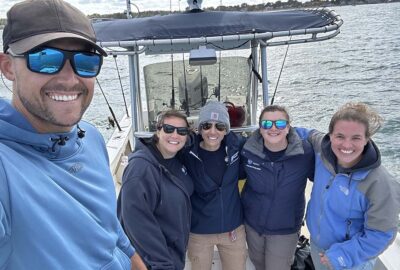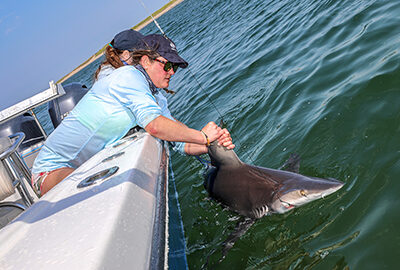Collaborating with Recreational Fishers to Study Bull Shark Survivorship
Dr. Ryan Knotek of our Anderson Cabot Center for Ocean Life is leading a study to assess the fate and recovery of bull sharks that are caught and released in US recreational fisheries.
By New England Aquarium on Wednesday, November 26, 2025


Bull sharks are a versatile species, found in warm ocean waters worldwide. Because they can thrive in both salt and fresh water, they’ve also been known to travel up rivers and into lakes and lagoons. An adult bull shark is big, growing to nine feet or more and weighing hundreds of pounds, and it has a notorious reputation as one of the more aggressive and dangerous sharks.
So, of course, the question arose: when encountering these animals in his research, was Dr. Ryan Knotek ever worried?
“Oh, I had a blast,” he said.

Partnering to protect sharks
For three years, Ryan, a research scientist in our Anderson Cabot Center for Ocean Life, has been leading a couple of projects to satellite tag sharks in the recreational (rod-and-reel) fishery along the southeastern US. His work has focused on two species that are popular with anglers: spinner sharks and bull sharks.
The National Oceanic and Atmospheric Administration’s (NOAA) Fisheries Cooperative Research Program provided funding for these projects. Through that program, Ryan and fellow Aquarium scientists and staff—working alongside NOAA collaborators—partner up with experienced charter captains fishing in these regions. This close collaboration with captains is key to the project’s success because it ensures the research reflects real fishing conditions and fishing practices that only seasoned captains can provide.

That’s important because information from this research will help inform future stock assessments and fishery management for these sharks. Questions about what happens when they’re caught and released—and how to improve fishing practices for healthier releases—are important to answer both for the people working in and enjoying these fisheries, and for the overall well-being of the animals and their population.
“For bull sharks, right now, no one knows the survival rate of these animals after they’re released,” Ryan said. That unknown makes it difficult for regulators to set proper guidelines, like catch quotas that are used to prevent overfishing and promote a sustainable fishery. “So, our work is filling in that data gap,” he added.
For the first time, NOAA is planning to assess bull sharks separately from other large coastal sharks in US fisheries; bull sharks are currently managed under the same regulations as six different species, including lemon sharks, tiger sharks, and spinner sharks. But because population numbers vary by species and research shows shark species respond differently to capture and handling, each species, like bull sharks, may require its own management strategy to support sustainable fishing. Bull sharks are also part of the growing conversation about depredation in US fisheries, being one of the main species purported to “steal” catch off the line.
Recent fieldwork
Ryan and team took two trips to Florida, partnering with five different charter captains on both the Gulf and Atlantic coasts to tag bull sharks. To catch them, fishers sometimes have to catch other fish first (which they use as bait), but just reeling these in can already attract bull sharks to the boat! Luckily for the team, the sharks often aren’t far behind—Florida waters are populated with several large shark species, and the bull sharks were easy to find on most days.

“At one point, we had at least 10 bull sharks beneath our boat,” Ryan said.
The charters are outfitted with the equipment needed to reel in these sharks once they’re on the line, but they’re still large and powerful animals, and it can take a bit of time (and a lot of effort!). Nearly all 31 sharks the team tagged were over 300-400 pounds, Ryan said. “We would not have been able to tag as many of them if we didn’t have those heavy-duty rods and conventional reels and extra hands to help with catching and handling these sharks.”
It’s quick work to attach the tags and collect size measurements, taking around two-to-three minutes per shark. Once they are deployed, the satellite tags stay on the bull sharks for 28 days, recording their vertical movement in the water. From there, researchers can assess the bull sharks’ survivorship after catch-and-release and estimate the species’ overall survival rate.
The tagging data is “part one” of the study, Ryan added. Researchers can also look at overall fishing practices and suggest changes that might improve the survivorship of these sharks. “We can give stock assessments the survival rate, and then we can recommend best practices when fishing for these animals to improve their condition at release,” he said.

Looking toward cooperative conservation
While Ryan and the team won’t have complete results until early December, the data they’ve gathered suggests that most bull sharks are surviving after their release. “We’ve only had one mortality so far,” he said. “The evidence so far points to this species being pretty resilient.”
It’s good news for the sharks and for recreational fishers, too. “Our goal is to balance the continued conservation of the population of these sharks while also supporting a continued, sustainable fishery,” Ryan said. “Our work is about trying to help people use the ocean responsibly.”




